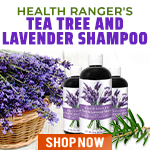
Brain-eating amoeba are proven vulnerable to extracts of an extraordinary, yet common Midwest American Indian plant
Saturday, September 21, 2013 by: Cody L
Tags: brain-eating amoeba, golden dalea, medicinal plants
- DEADLY FLU JAB WARNING: New flu vaccines make recipients 27 PERCENT MORE LIKELY to catch the flu
- Curcumin’s ancient healing power supercharges muscle recovery, and its effects are compounded with anti-inflammatory foods and supplements
- Trump’s EPA reviews fluoride safety amid growing concerns over risks to children’s health
- China’s counter-tariff strategies: A new chapter in the U.S.-China trade war
- WHO conducts a 2-day pandemic simulation called ‘Exercise Polaris’ - bringing together 350 predatory health groups worldwide
- CIA Official Terry Adirim TERMINATED for her role in pushing unlawful vaccine mandates on the military
- Barium detected in chemtrail fallout: Scientists suspect nuclear waste aerosolized over skies
- Aerosolized bioweapons? Strange “diploid biomasses” falling out of the sky in Florida captured under the microscope
- Fauci is back in the limelight, and he’s busy promoting a future COVID or FLU pandemic
- Tulsi Gabbard leads charge against the Biden regime’s global censorship of the 'Disinformation Dozen'
- Mysterious underwater pyramid off Japan could rewrite ancient history
- How Israeli military-connected corporations are secretly controlling your online privacy
- Chemtrails unveiled: How the CIA and Big Business are manipulating the weather for profit
- The hidden dangers of acetaminophen: Study links long-term use to ORGAN DAMAGE in seniors, but safer remedies are available
- Kiss Your Genetic Privacy Good-Bye! 23andMe Gets Green Light to Sell Your Intimate Genetic Details to Anyone They Want
- New study confirms brown rice contains 40% more toxic arsenic than white rice, putting young children at risk
- U.S. lawmakers investigate Meta over alleged China collaboration
- The art of minimalist prepping: Essential strategies for a simpler emergency plan
- Aerosolized bioweapons? Strange “diploid biomasses” falling out of the sky in Florida captured under the microscope
- Widespread social and economic unrest: Steve Quayle issues urgent financial warning of imminent asset collapse in new interview with Mike Adams
- Analysis: The coming economic collapse, a mass uprising and Trump's three secret weapons to halt the growing revolt
- Kiss Your Genetic Privacy Good-Bye! 23andMe Gets Green Light to Sell Your Intimate Genetic Details to Anyone They Want
- CLOT SHOT PLANDEMIC UNFOLDING: Fibrous, rubbery clots caused by covid injections have prion-like seeding activity
- Defunding DEADLY mRNA jabs: Government funding for mRNA technology being scrutinized and sidelined until proven "safe and effective" for real
- Mike Adams releases country western hit single: Goin’ Back in Time is Comin’ Home
- How Israeli military-connected corporations are secretly controlling your online privacy
- DEATH by VACCINE or face PRISON time: Canadian Freedom Convoy leaders CONVICTED for protesting forced vaccination during the Covid Plandemic
- European Court of Justice: Healthcare professionals who promoted or administered COVID-19 vaccines are CRIMINALLY LIABLE for any harm caused
- Tulsi Gabbard leads charge against the Biden regime’s global censorship of the 'Disinformation Dozen'
- Fauci is back in the limelight, and he’s busy promoting a future COVID or FLU pandemic
- Tulsi Gabbard takes aim at censorship: Justice for the ‘Disinformation Dozen’
- The hidden war above: Chemtrails, HAARP and the battle for planetary control
- “Project Aldrin”: Senate probes Meta's alleged censorship dealings with China
- Federal employees whine over DOGE's new directive requiring them to do a 5-point summary of weekly accomplishments
- U.S. approves new Russian ambassador as diplomatic thaw continues
- I Want My Bailout Money – new song and music video released by Mike Adams
- Newly released JFK files reveal Pentagon's role in creating Lyme disease and covid in the same lab
- Mike Adams releases country western hit single: Goin’ Back in Time is Comin’ Home
- Analysis: The coming economic collapse, a mass uprising and Trump's three secret weapons to halt the growing revolt
- Dr. Mike Yeadon releases 15-minute testimony - WATCH - about genocidal intent of COVID “vaccines”
- MEDICAL BOMBSHELL: FDA admits Covid mRNA 'Vaccines' CAUSE CANCER
- The Health Ranger releases “Vaccine Zombie” song and music video, using AI-animated zombies for the music video
- California's social media censorship law struck down: A victory for free speech or a threat to online safety?
- EPA advisor admits the agency is funneling billions to climate groups ahead of Trump’s return to White House
- Trump reverses course on Gaza plan, says “nobody is expelling Palestinians”
- Survival 101: Effective EMF blocking techniques
- Rep. Nancy Mace introduces bill to ban biological males from female facilities on federal property
- OpenAI whistleblower who dissented against how the company trained ChatGPT found dead
- 5 Simple steps to boost your brainpower: How to strengthen executive function in a distracted world
- CONSERVATIVES SOUND THE ALARM: Big Pharma and the Left trying to force $32 billion money grab from America’s seniors into year-end spending deal
- Florida takes a stand: DeSantis proposes permanent ban on mRNA vaccine mandates
- Sugarcane extract superior to cholesterol-lowering drugs?
- Pilots report mysterious lights 'moving at extreme speeds' across Oregon skies
- Trump Administration cuts 2,000 USAID jobs, places most employees on leave in sweeping reform effort
- Red Cross issues warning to stop blood plasma donations from vaccinated people
- Scientists confirm: GENIUS brain function can be spontaneously unleashed in humans without any apparent cause
- EPA advisor admits the agency is funneling billions to climate groups ahead of Trump’s return to White House
- HYSSOP: What research reveals about the health benefits of this ancient holy herb
- Two containers with completed ballots fall out of truck in Florida
- Fully vaccinated about to see “tsunami” of illness and death, warns virologist
- Global leaders unite to clamp down on “misinformation” with UN-backed Cascais Declaration
- Newly released JFK files reveal Pentagon's role in creating Lyme disease and covid in the same lab
- BREAKING: 2025 NDAA authorizes mandatory military draft of WOMEN across America… as Pentagon pursues global NUCLEAR war with both Russia and China at the same time
- Michael Yon warns of a ZIONIST TAKEOVER in Trump’s second administration
- Ozempic and Wegovy weight loss drugs are injectable LIZARD VENOM PEPTIDES that may unleash a devastating wave of organ failure… side effects align with symptoms of SNAKE BITES
- The Health Ranger releases “Vaccine Zombie” song and music video, using AI-animated zombies for the music video
- BOMBSHELL: DNA testing kits are a SCAM to develop ethnic-specific bioweapons
- Israeli soldiers accused of even more torture and abuse in the West Bank
- These 13 countries just signed an agreement to engineer a global FAMINE by destroying food supply
- NASA admits that climate change occurs because of changes in Earth’s solar orbit, and NOT because of SUVs and fossil fuels
- RFK Jr. clears key hurdle: Sen. Susan Collins backs controversial HHS nominee, signaling a new era for health policy
- Sermon 30: How Jesus reveals Caesar’s FAKE CURRENCY and FALSE AUTHORITY
A sole flower stands strong, a unique source between all amoebicidal plants to target brain-eating amoeba
Just 400 miles to the west of New Orleans, the site of the latest onslaught by Naegleria this September in St. Bernard Parish, where a 4-year-old boy was infected and died after playing on a toy water slide, grows a special type of Native American medicinal flower. As far east as Texas and all over the prairie states and Midwest are bountiful stands of Dalea aurea, or the golden dalea (Golden prairie clover). This flower of the bean family was studied in Tulsa, Oklahoma, in 2006 by Belofsky G. and others, and their results were published in March that year in Planta Medica. Importantly, they tested an extract produced by crushing the flowers into dust and submerging them in methanol. The methanolic extract of golden dalea was found to be superior to amphotericin B, the synthetic antifungal that is the preferred treatment for N. fowleri infections, in a trial over 7 days, proving to be more potent than the drug starting on day four.Almost beyond belief, just one more flower was found endowed with selective anti-Naegleria action
While the results are promising, and after thoroughly scouring the archives, it can be seen that there are no other plant extracts shown to be tested on this brain-eating amoeba, these results are preliminary. It would be inhumane to infect humans with this pathogen even in laboratory settings, so there will never be clinical trials. Therefore, it seems that the Native Americans living on Midwestern reservations may be the only source of testimony for the efficacy of alcohol extracts of golden dalea. Interestingly, while it may prove controversial, as far back as 1979, Cannabis sativa or marijuana extracts were tested for "anti-naeglerial activity." At 5 to 50 micrograms per milliliter, delta 9-THC, the (partly) illegal and psychoactive component was found to be "amoebostatic" and halted it's growth in liquid media. THC was not the only active component, as they found that 16 of 17 tested cannabinoids were potent against the brain-eating amoeba strain. In the full paper, it is stated "Delta-9-THC afforded some protection in mice to naeglerial infection. The protection afforded by Delta-9-THC involved both extension of life and 25% fewer deaths." This was groundbreaking, but devastatingly neglected for preventing the hundreds of deaths that would occur over the next few decades. There are literally no other plant extracts ever shown to target N. fowleri. There comes a time when chlorine and antifungals don't cut it. Taking it a step further, one could prepare alcohol extracts of golden dalea and Cannabis sativa together to generate combined additive effects.Sources for this article include:
http://www.ncbi.nlm.nih.gov
http://www.ncbi.nlm.nih.gov
http://www.cnn.com
http://www.cnn.com
http://www.discoverlife.org
http://www.seedsource.com
About the author:
Cody Lakeland is a freelance writer in fields such as nutrition, phytomedicine, neurology, gerontology, epigenetics, and toxicology. He currently helps to coordinate the formulas for a internet/home-based community business specializing in customized alternative therapies.
Brain-eating amoeba at FETCH.news
Get independent news alerts on natural cures, food lab tests, cannabis medicine, science, robotics, drones, privacy and more.
Take Action: Support Natural News by linking to this article from your website
Permalink to this article:
Embed article link: (copy HTML code below):
Reprinting this article:
Non-commercial use OK, cite NaturalNews.com with clickable link.
Follow Natural News on Facebook, Twitter, Google Plus, and Pinterest
Science News & Studies
Medicine News and Information
Food News & Studies
Health News & Studies
Herbs News & Information
Pollution News & Studies
Cancer News & Studies
Climate News & Studies
Survival News & Information
Gear News & Information
News covering technology, stocks, hackers, and more



"Big Tech and mainstream media are constantly trying to silence the independent voices that dare to bring you the truth about toxic food ingredients, dangerous medications and the failed, fraudulent science of the profit-driven medical establishment.
Email is one of the best ways to make sure you stay informed, without the censorship of the tech giants (Google, Apple, Facebook, Twitter, YouTube, etc.). Stay informed and you'll even likely learn information that may help save your own life."
–The Health Ranger, Mike Adams











































